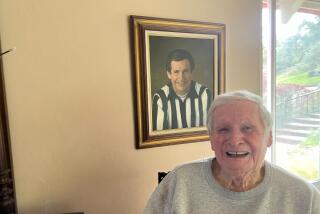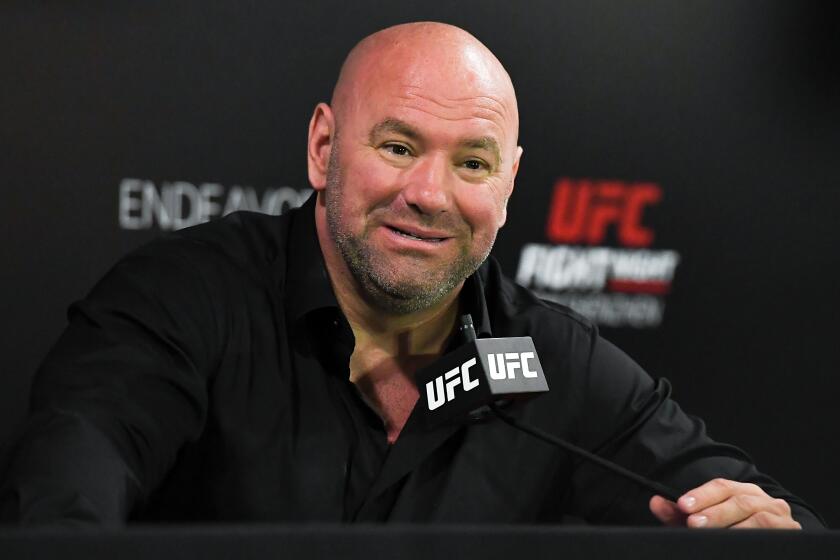There Is No Fight Anymore
“In the kingdom of the blind, the one-eyed man is king.” “In the valley of the halt, the man on a jackass rules.”
--Proverbs
How good is heavyweight champion Mike Tyson? As good as Dempsey? Louis? Marciano? Jack Johnson? James J. Jeffries? Tunney? John L. himself?
Probably all of the above. Possibly none of the above.
He’s the best of his time--as all of the others were.
It’s the time that needs investigating.
Is a baseball player today better than his predecessors? Undoubtedly.
Before 1946, an eighth of the population was disenfranchised. Before Jackie Robinson, you didn’t have to pitch, bat or run against a black player. That was your good luck. Because we know that you were not nearly tested enough when some of the best athletes in the society were not on the field.
I mean, who would you rather try to line a three-base hit against, Willie Mays or Smead Jolley?
Who would you rather pitch against, the 1938 St. Louis Browns, or a lineup with Henry Aaron or Roberto Clemente or Wilver Stargell--or all three--in it?
Football did not specifically disbar the best players. The trick there was, you had to go to college to get in the football swarm. The cotton fields produced great athletes but did not allow for many college prospects.
Boxing did not draw any color line. Before Jack Johnson, you had Joe Gans, George Dixon, the original Joe Walcott. In the heavyweights, you had Peter Jackson, Sam Langford, the great Tom Molineaux, the escaped slave who thrashed England’s best in the early 19th Century.
Jack Johnson, if anything, almost sent a desegregated sport shudderingly into reverse with his flamboyant life style. But even in the ‘20s, when other sports were lily white, boxing had its Tiger Flowers, George Godfrey, Harry Wills (Dempsey ducked him but Sharkey whipped him), Battling Siki, Kid Chocolate, Panama Al Brown.
The paradox today is, it’s the white fighter who has all but disappeared. And, even though that may not be as serious a defection as the absence of black fighters, still it is a numbers game.
Look at it this way: Mike Tyson is the best fighter of a group of, oh, say, 40. Certainly, there are no more certified heavyweights of any championship caliber than that. You can almost count them on the fingers of two hands.
When times were hard, the gyms were full. Every town in America had a fight club and weekly, sometimes nightly, cards. Amateur boxing proliferated.
By sheer weight of numbers, you had to be good to excel. You never had the spectacle of a guy becoming champion in his eighth professional fight, as happened to Leon Spinks. What was more likely was that you would get your first title shot in your 172nd fight as Archie Moore did.
So, is Mike Tyson one of pugilism’s immortals or is he, so to speak, the best break dancer in Lapland? As they say around a race track, who’d he ever beat?
It’s not his fault the heavyweight division consists of a bunch of fat old parties who can’t even seem to eliminate each other. I’m sure he’d like to take part in a ring war like that waged by Dempsey and Firpo, or be tested by someone with the artistry of a Muhammad Ali or Gene Tunney. But where are they? The pipelines are empty. The art of fisticuffs is declining.
So he looked like a world beater rolling over Michael Spinks. But the cold truth of the matter was, Michael Spinks was never a true champion, certainly not a heavyweight champion. He was what the fight mob used to call a “manufactured” fighter. He fought by the numbers.
He was never as willing a banger as his brother Leon. His skills were limited, his stamina finite, his firepower low caliber to nonexistent. He was in no man’s land with a screwdriver. He couldn’t befuddle Tyson because Tyson doesn’t think. He just attacks. His fight plan is early wrecking ball.
The fight had one-round knockout written all over it. Michael Spinks would not have gotten out of the six-round prelims 55 years ago. He was nowhere near the best fighter we had at the Montreal Olympics in 1976. Sugar Ray Leonard was assuredly superior as were the other Spinks, Howard Davis and even Leo Randolph, all 110 pounds of him.
Michael Spinks just always seemed to be standing on the right street corner at the right time. Larry Holmes, in his waning powers, decided to give him the shot that would enable Larry to break Rocky Marciano’s all-time win record. Michael Spinks was just a high-class spoiler, a world-class survivor.
He improvised a career. He had no distinct style, speed, design. He was like a character actor who could play anything, none of them memorably.
He ran out of mirrors Monday night. He was as defenseless as if he had been tied to the track and the limited was on time. Tyson knew he wasn’t anything. Tyson would have more trouble with a subway turnstile.
“Now, he tells us!” you may say.
Well, the state of boxing today is such that it’s hard to make a simple declarative sentence about it without running a big risk of being wrong. No matter how bad Michael Spinks is, how can you be sure Michael Tyson is any improvement?
Has he come up through the teeming ranks? Has he seen enough real ring generalship so that he can be confidently expected to perform at a consistent level of excellence of, say, Joe Louis or Ali? Does he really know his craft well enough that he can summon up the reserves of experience when things don’t go the way they were diagrammed?
We’ll probably never know. Because there aren’t thousands of kids out there anymore, practicing on the heavy bag and dreaming of the night they can get in the ring with the champ and get their picture on the cover of Sports Illustrated and marry an actress and have cars to give away.
The kids today are dreaming of ways to beat Magic Johnson. He’s a guy who has to be the real heavyweight champion of his sport. Tyson rules over an empire of frayed grandeur. He’s the champion of a whole bunch of Michael Spinkses.
More to Read
Go beyond the scoreboard
Get the latest on L.A.'s teams in the daily Sports Report newsletter.
You may occasionally receive promotional content from the Los Angeles Times.









